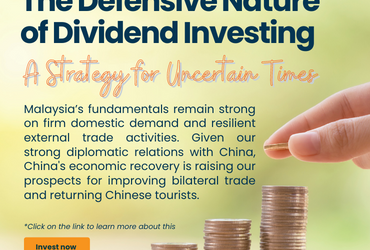
Overview
On September 1st, Prime Minister Anwar Ibrahim introduced the New Industrial Master Plan 2030 (NIMP 2030), an industrial policy for the manufacturing and manufacturing-related services sectors spanning seven years until 2030, focusing on 6 high-impact sectors, namely aerospace, chemicals, electrical & electronics, electric vehicles, pharmaceuticals, and advanced materials. The masterplan aims to generate a substantial impact on Malaysia’s economy, with projected contributions of RM587.5 billion to the total GDP by 2030, representing a remarkable growth of 61% compared to 2022. Additionally, the plan targets a 20% increase in employment levels by 2030, and it aspires to elevate the median salary to MYR4,510 by 2030, reflecting an impressive surge of 128.0% from the 2021 level. To note, manufacturing sector accounted for 24.1% of 2022 GDP, the second largest contributor after services, roughly 80% of total exports in 2022 and 17% of employment.
Compared to the previous Industry Master Plans (IMP), the NIMP 2030 takes another transformative strategy, shifting from sectoral-based approach to mission-based approach. The goals and targets are formulated as below:

Source: NIMP 2030 Booklet
An estimated total investment of MYR95bn will be required under NIMP 2030. This investment is expected to primarily originate from the private sector, mobilised through private equity, capital markets, and financial markets. Of these investments, the government is expected to contribute RM8.2bn (8.6% of the total) through the NIMP Industrial Development Fund and the NIMP Strategic Co-investment Fund. Additional incentives related to NIMP 2030 will be disclosed during the presentation of Budget 2024 on October 13th, according to MITI.
Another noteworthy facet of NIMP 2030 is its emphasis on addressing social and income inequalities, along with its commitment to enhance Environmental, Social, and Governance (ESG) practices by adopting greener production processes. As part of this strategic initiative, the government aims to accelerate the adoption of electric vehicles (EVs) to hasten the decarbonisation of Malaysia’s transportation sector. Concurrently, it seeks to nurture the development of carbon capture, utilisation, and storage (CCUS) as a new potential solution to carbon management. Separately, in the coming weeks, MITI will unveil an ESG Framework aimed at assisting SMEs in enhancing their access to export markets that prioritise ESG considerations. Additionally, this framework will facilitate SME engagement in MNC vendor ecosystems that uphold ESG standards.
Our View
NIMP 2030 outlines Malaysia’s prospective path for industrial transformation, serving as a comprehensive plan for fostering resilient industrial development until 2030. We view this as a positive move to bring Malaysia forward but given the relatively short time frame (7 years), its effectiveness hinges on robust collaboration among various pivotal stakeholders, spanning both federal and state governments and agencies. On top of that, the government seems to be cognizant of the challenges and obstacles within the current industrial landscape, such as its heavy reliance on foreign labour and limited rooms of research and development (R&D), hence the plan serves as a high-level strategic plan for the nation’s development.
Some may argue that the RM95bn investments (or RM13.5bn annually) may be insufficient in terms of the incremental value it contributes to GDP, and there could be concerns about the private sector’s willingness to support it, as out of the total RM95bn required, only RM8.2bn will be provided by the government, while the remainder is expected to be funded by the private sector. However, we should highlight that this view does not construe anything negative as according to the plan, the plan seeks to support industries in advancing their positions in the value chain, building a robust ecosystem, decreasing reliance on external supply chains, and conducting focused research and development in key sectors, which ultimately will benefit the private sector, people and country as a whole.
We are also pleased that NIMP 2030 strives to enhance ESG practices and we firmly believe that placing a strong emphasis on ESG and developing a plan to tackle this matter will pave the way for a more sustainable and responsible approach to development. Additionally, investors are progressively considering ESG in their investment decisions as ESG compliance has become critical. Finally, the plan certainly improves the long-term prospects for GDP growth and overall return profile which would naturally drive market valuation higher in the long term.
Please click on the link to learn more or email us at cse.my@phillipcapital.com.my if you require any further information.
Disclaimer:
The information contained herein does not constitute an offer, invitation or solicitation to invest in Phillip Capital Management Sdn Bhd (“PCM”). This article has been reviewed and endorsed by the Executive Director (ED) of PCM. This article has not been reviewed by The Securities Commission Malaysia (SC). No part of this document may be circulated or reproduced without prior permission of PCM. This is not a collective investment scheme / unit trust fund. Any investment product or service offered by PCM is not obligations of, deposits in or guaranteed by PCM. Past performance is not necessarily indicative of future returns. Investments are subject to investment risks, including the possible loss of the principal amount invested. Investors should note that the value of the investment may rise as well as decline. If investors are in any doubt about any feature or nature of the investment, they should consult PCM to obtain further information including on the fees and charges involved before investing or seek other professional advice for their specific investment needs or financial situations. Whilst we have taken all reasonable care to ensure that the information contained in this publication is accurate, it does not guarantee the accuracy or completeness of this publication. Any information, opinion and views contained herein are subject to change without notice. We have not given any consideration to and have not made any investigation on your investment objectives, financial situation or your particular needs. Accordingly, no warranty whatsoever is given and no liability whatsoever is accepted for any loss arising whether directly or indirectly as a result of any persons acting on such information and advice.






